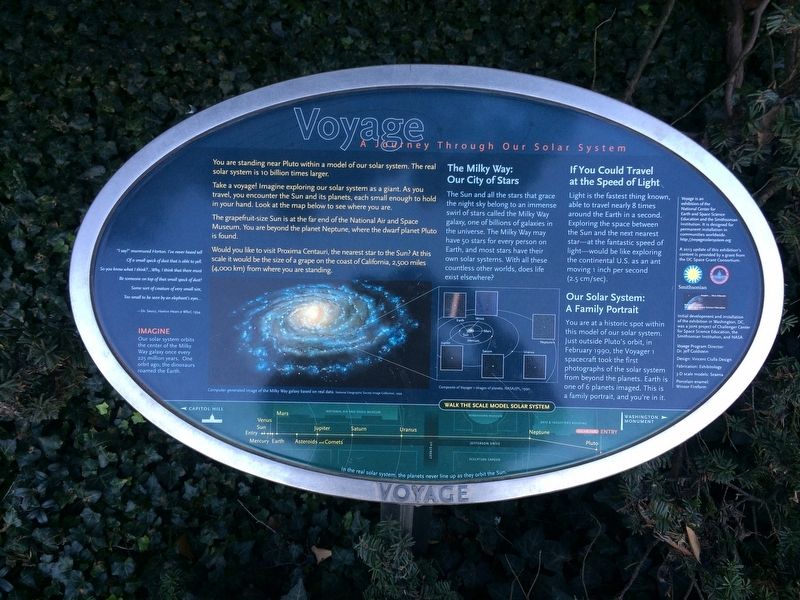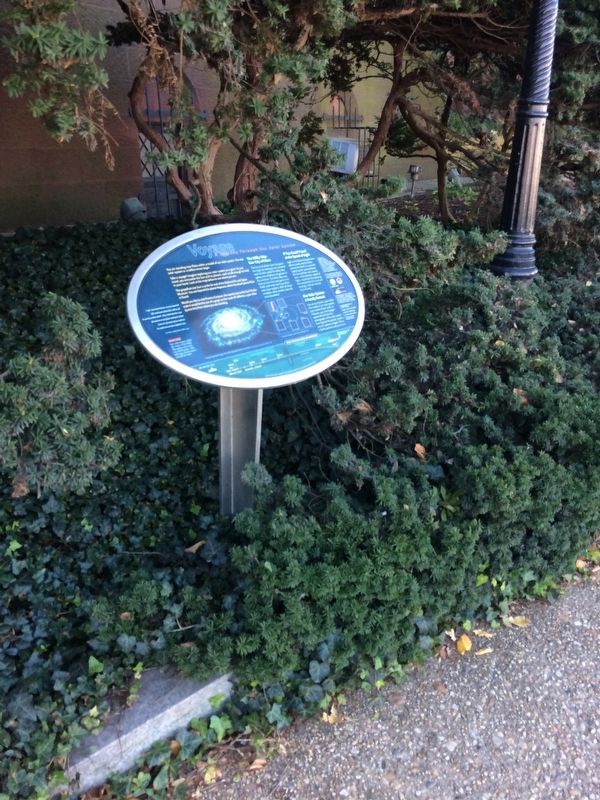The National Mall in Southwest Washington in Washington, District of Columbia — The American Northeast (Mid-Atlantic)
Voyage
A Journey Through Our Solar System
You are standing near Pluto within a model of our solar system. The real solar system is 10 billion times larger.
Take a voyage! Imagine exploring our solar system as a giant. As you travel, you encounter the Sun and its planets, each small enough to hold in your hand. Look at the map below to see where you are.
The grapefruit-size Sun is at the far end of the National Air and Space Museum. You are beyond the planet Neptune, where the dwarf planet Pluto is found.
Would you like to visit Proxima Centauri, the nearest star to the Sun? At this scale it would be the size of a grape on the coast of California, 2,500 miles (4,000 km) from where you are standing.
The Milky Way: Our City of Stars
The Sun and all the stars that grace the night sky belong to an immense swirl of stars called the Milky Way galaxy, one of billions of galaxies in the universe. The Milky Way may have 50 stars for every person on Earth, and most stars have their own solar systems. With all these countless other worlds, does life exist elsewhere?
If You Could Travel at the Speed of Light
Light is the fastest thing known, able to travel nearly 8 times around the earth in a second. Exploring the space between the Sun and the next nearest star—at the fantastic speed of light—would be like exploring the continental U.S. as an ant moving 1 inch per second (2.5 cm/sec).
Our Solar System: A Family Portrait
You are at a historic spot within this model of our solar system. Just outside Pluto's orbit, in February 1990, the Voyager I spacecraft took the first photographs of the solar system from beyond the planets. Earth is one of 6 planets imaged. This is a family portrait, and you're in it.
"I say!" murmured Horton. I've never heard tell
Of a small speck of dust that is able to yell.
So you know what I thing?…Why, I think there must
Be someone on top of that small speck of dust!
Some sort of creature of very small size,
Too small to be seen by an elephant's eyes…
—Dr. Seuss, Horton Hears a Who!, 1954.
Imagine
Our solar system orbits the center of the Milky Way galaxy once every 225 million years. One orbit ago, the dinosaurs roamed the Earth.
Erected by Smithsonian Institution.
Topics. This historical marker is listed in this topic list: Air & Space. A significant historical month for this entry is February 1990.
Location. 38° 53.333′ N, 77° 1.515′ W. Marker is in Southwest Washington in Washington, District of Columbia. It is in The National Mall. Marker is on Jefferson
Other nearby markers. At least 8 other markers are within walking distance of this marker. Pluto (here, next to this marker); Enid A. Haupt Garden (within shouting distance of this marker); An Apple is a Rose? (within shouting distance of this marker); A Common Language (within shouting distance of this marker); Andrew Jackson Downing Urn (within shouting distance of this marker); Carousel on the Mall, Washington, D.C. (within shouting distance of this marker); The Modern Rose (within shouting distance of this marker); Original Smithsonian Institution Building (within shouting distance of this marker). Touch for a list and map of all markers in Southwest Washington.
More about this marker.
Voyage is an exhibition of the National Center for Earth and Space Science Education and the Smithsonian Institution. It is designed for permanent installation in communities worldwide.
http://voyagesolarsystem.org
A 2013 update of this exhibition's content is provided by a grant from the DC Space Grant Consortium.
Initial development and installation of the exhibition in Washington, DC, was a joint project of Challenger Center for Space Science Education and the Smithsonian Institution, and NASA.
Voyage Program Director: Dr. Jeff Goldstein
Design: Vincent Ciulla Design
Fabrication: Exhibitology
3-D scale models: Seaena
Porcelain enamel: Winsor Fireform
Credits. This page was last revised on January 30, 2023. It was originally submitted on November 28, 2017, by Devry Becker Jones of Washington, District of Columbia. This page has been viewed 211 times since then and 18 times this year. Last updated on December 29, 2019, by Bruce Guthrie of Silver Spring, Maryland. Photos: 1, 2. submitted on November 28, 2017, by Devry Becker Jones of Washington, District of Columbia.

